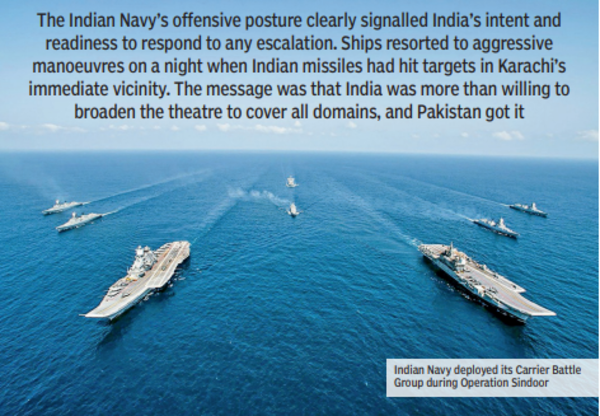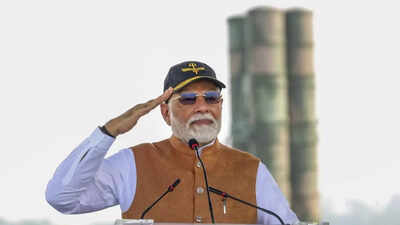The inside story of a seamless Operation Sindoor | India News

Wars always generated a fog of claims and counter-claims. Did the Americans deliberately target civilians? Did a cynical Saddam Hussein use hospitals and schools as shields? It was always difficult to sift the truth from the lies, but the problem now has become even more acute with that much more information manipulation by the combatants. During Operation Sindoor, the same game played out, but one thing has now become abundantly clear: India won the latest round decisively. Indian armed forces have given enough information, backed by photographs and satellite images, leaving little room for disputes by sceptics and biased pundits masquerading as objective neutral parties. The assertions have been backed by independent military strategists and experts. TOI, based on accounts from multiple high-level insiders, who obviously spoke on the condition of anonymity, pieced together how India executed Operation Sindoor.

Operation Sindoor
Resolute political willPrime Minister Narendra Modi was busy with his engagements in Saudi Arabia when news of the attack on tourists in Pahalgam started trickling in. As soon as the magnitude of the massacre — the sheer monstrosity of the act, the fact that only Hindu men were targeted — was clear, Modi made up his mind that this would not go unpunished. The terrorists had even taunted wailing family members of victims that this was a message to Modi. The PM cut short his visit and on the way back told his colleagues to start preparing for retaliation against terrorists and their patrons. The consultations in the Cabinet Committee on Security and with the defence and intelligence leadership were not about “if” we should retaliate. It was solely focused on “where and when”, sources told TOI. In 2019, Modi had called Pakistan’s nuclear bluff when he ordered the air strike on the jihadi hub of Balakot in response to the Pulwama attack on a CRPF convoy. He was determined not to let that be an obstacle this time around as well despite alarmist predictions about Pakistan army chief Gen Asim Munir being a jihadi in olives who had a restless finger on the nuclear button. India also factored in that China and Turkiye were standing by Pakistan, that a large number of Indian troops were stationed along the China border, and also that the West was again getting spooked by Pakistan’s scare-mongering. None of this dimmed India’s resolve which was articulated by the PM in Madhubani. Choice of targets The 2016 surgical strikes after the terror attack at an Army camp in Uri signalled the intent not to let the LoC come in the way of India’s pursuit of justice. The govt climbed up a couple of steps in the escalation ladder through the air strike on Balakot — a revered spot in the jihadi imagination. This time, the message had to be stronger and, hence, the selection of Muridke and Bahawalpur, the headquarters of Lashkar-e-Taiba and Jaish-e-Mohammed, which had been responsible for almost all the major terror attacks on India, beginning with the audacious one on Parliament in 2001 and including the amphibious army-type assault on Mumbai in 2008. The headquarters of Hizbul Mujahideen and other areas in POK, which were the staging ground for attacks, were part of the ‘to-hit’ list drawn up with the help of meticulous intelligence the govt already had. Forty-odd buildings were priority targets and the objective was to inflict damage that was visible, lethal and served to amplify the message: “We know who you are, where you are and how to get you.gClosing intel gap Painstaking intelligence gathering over the past 10 years has helped India take care of what has for decades been a major handicap vis-a-vis its hostile neighbour. The success of Operation Sindoor only served to confirm what had been speculated over the past couple of years: that India has closed the intelligence gap. A combination of humint and techint helped India pin the exact locations, down to the buildings that served as the residential quarters of the leaders of Lashkar and Jaish inside the sprawling complexes at Muridike and Bahawalpur. Ten members of the family of Masood Azhar died. He himself barely escaped an Indian missile. Such was the extent of the losses that the Pakistan army had to depute its senior ranks to attend their funeral: an act of solidarity which blew apart the fiction of jihadi outfits being non-state actors. They knew it was coming Uri and Balakot had left little room for doubting the Modi govt’s intent. Right after the Pahalgam attack, speculation was rife that India would target terror hubs, especially the jihadi universities at Muridke and Bahawalpur. It was also certain that Pakistan, caught napping twice, would have ramped up defences around its “prized assets”, thus eliminating the room for India to spring a surprise. Yet, two weeks after the Pahalgam massacre, India decided to hit the very same targets. Sources refused to confirm if it was because our intelligence had signalled that Pakistan had lowered its guard. It certainly created a “bol ke mara, jo kaha so kiya” moment for the govt and the forces. Choice of weapons Intelligence also helped India exploit a chink in Pakistan’s air defence. The Rawalpindi GHQ and their Chinese handlers had designed a shield to defeat any attack that involved planes and missiles. But they did not take into account India’s stock of loitering munitions (a type of drone). A deadly addition to the inventory, loitering munitions fly at low altitude to dodge regular air defence, hunt and hover over the target with exact coordinates fed into it, before striking with precision. Over the past few years, India has built an impressive arsenal of the stealth weapon, largely sourced from overseas through the Emergency Purchase route, but now increasingly being produced domestically too. Combined with longrange Made-in-India drones, they took a heavy toll on the nine terror targets. Once they had got the “free hand” from the PM, defence and intelligence officers started working on the execution of Operation Sindoor. What helped them were multiple simulations the three Services had run, enabling near-perfection in the implementation. The four-day operation saw them work together: a perfect example of the muchaspired-for “jointness” that India has sought to achieve in recent years. There is speculation that some of the most ferocious strikes were achieved through weapons fired by Navy personnel. Air defence held firm The destruction near Lahore of the HQ-9 missile defence system, a copycat version of the Russian S-300, and a strategic gift from China, marked a major blow to Pakistan, both materially as well as psychologically. But this was only a prelude to the major unravelling of Pakistan’s air defence.Their air bases, including strategic ones, which are home to F-16s and Chinese-made J-10s, and those located next to the headquarters of Strategic Plans Division that handles their nukes, became vulnerable. Open to missile and drone attacks, it exposed the hollowness of Bunyanum Marsoos, the ‘wall of lead’ that Pakistanis had claimed to have built. As against this, India’s own air fortification remained intact. A combination of the legacy antiaircraft guns, surface-to-air missiles, particularly the portable ones, battle-proven Pechoras, indigenously developed Akash, and S-400 that India acquired from Russia in 2018 in defiance of US’s threat of sanctions, turned out to be “the wall”. In another example of jointness, the capabilities of the Indian Air Force and the Army were supplemented by those of the Navy. As a result, all our air bases remained safe and operational. Pakistan’s claims about the destruction of the Adampur air base were proven to be fiction on Tuesday when Modi landed there on his special plane to address the jawans, with S-400 Triumph batteries forming a defiant backdrop. The military success announced India’s fullscale readiness for new-age warfare and will go a long way in enhancing confidence of the armed forces in “Make-in-India” weapons. Threat within PakistanPakistan had limited options of widening the theatre of war by opening a front on the land border. With the Baloch insurgency developing into a front within, Gen Asim Munir could have withdrawn the Chaklala-headquartered X Corps — tasked with defending Pakistan-Occupied Kashmir — from Balochistan, but only at a huge risk. Attacks by Balochistan Liberation Army, even during the hostilities with India, only further shrank the space for manoeuvre. The vulnerability of Pakistan’s skies and the high possibility of Baloch snipers aiming at long convoys meant that the 26 division — the mechanised division based in Bahawalpur — could not be brought to the border either. Missing ‘strategic depth’ Pakistan had wanted to turn Afghanistan into a client state, hoping that its control over its neighbour would give it strategic depth in any confrontation with a conventionally superior India. The retreat of the US and the installation of a Taliban regime was supposed to be the fulfilment of the dream of the planners at Rawalpindi GHQ. Unfortunately for them, the new regime in Kabul has refused to be pliant and an accessory, leading Islamabad to ironically accuse them of not controlling Tehreek-e-Taliban Pakistan. It has also made it necessary for Pakistan to deploy a sizeable number of its troops in the Khyber Pakhtunkhwa province bordering Afghanistan. Staunch solidarity of the majority in KP with jailed former PM Imran Khan and the fear that his supporters would erupt in the streets against the Pakistan army further tied Islamabad’s hands. Navy, the amplifierIt did not join the action as such. But its offensive posture clearly signalled India’s intent and readiness to respond to any escalation. Ships resorted to aggressive manoeuvres on a night when Indian missiles had hit targets in Karachi’s immediate vicinity. The message was that India was more than willing to broaden the theatre to cover all domains, and Pakistan got the message. As Vice Admiral AN Pramod said, the Indian Navy ensured that the enemy’s air force remained “bottled up” on the Makran coast. Staying the course Stoking the West’s fears of a nuclear conflagration and capitalising on it has for decades been Pakistan’s playbook. The tactic was deployed again and it worked, with Western capitals offering unsolicited counsel to New Delhi to de-escalate. The Modi govt, however, refused to flinch and maintained that terrorists needed to be made accountable and India has the right to defend its citizens. The message, in its most stark form, was conveyed by the PM to US vice-president J D Vance on the evening of May 9. Vance had called to convey “intelligence” about Pakistan planning a massive retaliation. “They can do whatever they are planning to, but India’s response will be even stronger,” Modi is learnt to have told Vance. That Modi really meant “goli ka jawab gole se” became evident in hours. After the IAF humiliated Pakistan by hitting its prized air bases, external affairs minister S Jaishankar got a call from US secretary of state Marco Rubio on Saturday morning, saying that Pakistan was ready to discuss a ceasefire. India’s first response was to escalate the strikes on Pakistan’s air bases before its Director General of Military Operations Lt General Rajiv Ghai decided to connect with his counterpart Maj Gen Kashif Abdullah. The biggest takeaway for Pakistan and the world at large: Since the global community is unable or unwilling to force Pakistan to change its behaviour, India is ready to execute the task on its own, despite significant risks. And it is sure the people will back a govt that is ready to go to the farthest lengths.




